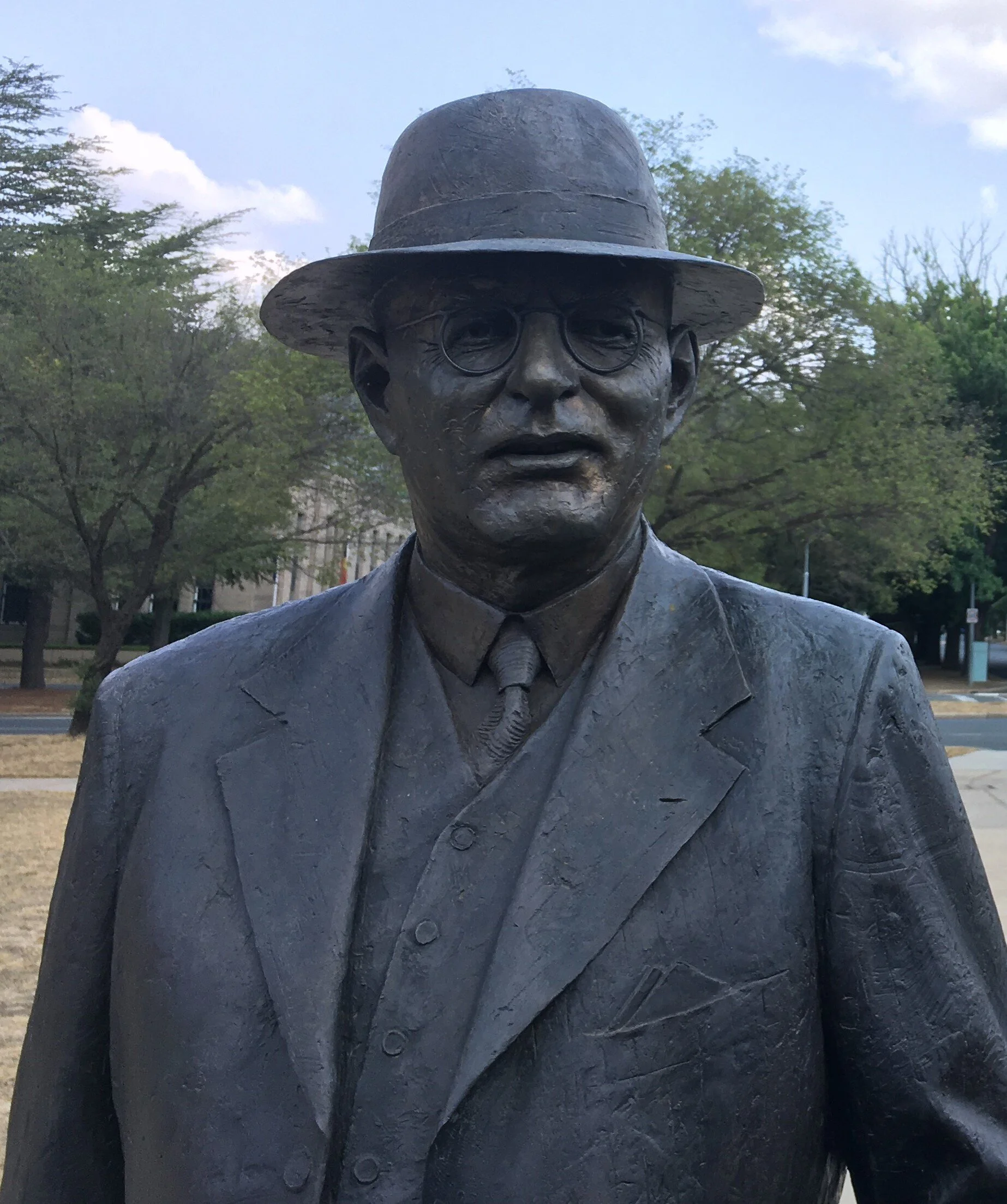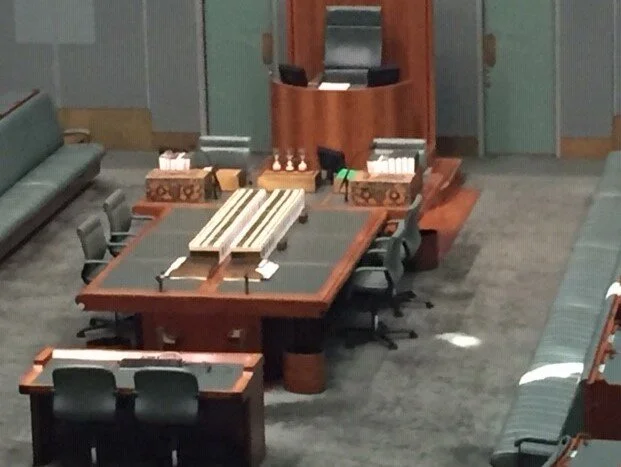No. 3 Bronze sculpture of Prime Minister John Curtin, Canberra 100
Canberra 100
In 2020 Capital history here is exploring Canberra’s history by identifying objects that can connect us with Canberra’s past. The aim is to tell the story of Canberra by finding 100 objects that represent the history of the city. Two objects have been identified so far, the Canberra red brick and the Cummings concrete bus shelter.
The bronze sculpture of Prime Minister John Curtin located in the heart of the Parliamentary Triangle, is No.3 in the Canberra 100 series. Its mate the sculpture of Prime Minister Ben Chiefly will be the focus of a later post.
Remembering leadership
Much has been written about the Australian character’s distaste for authority but perhaps the counterbalance is an acute appreciation for leadership at times of national crisis. This accounts, in large part, for the endearing sculptures of Prime Ministers John Curtin and Ben Chiefly found on Walpole Crescent in Parkes, about 700 metres from Old Parliament House. Both men are Labor heroes but are also admired across political divides because they advanced Australia in the difficult years of World War 2 and post-war reconstruction.
The sculpture, Prime Minister John Curtin and Treasurer Ben Chifley, ca 1945
The sculpture Prime Minister John Curtin and Treasurer Ben Chifley, ca 1945 is by Peter Corlett OAM a leading Australian figurative sculptor best known for his full-figure portrait sculptures cast in bronze, including the Australian War Memorial’s much loved sculpture of Simpson and his donkey.
The inspiration for the artwork was a photograph taken in 1945 by Don Stephens showing the two men walking in conversation from the Kurrajong Hotel to Parliament House. The sculpture has been located as close to the site of the original image as possible.
The ACT Government commissioned the artwork in 2010. You can read more about this here. Prime Minister, Julia Gillard launched the sculpture on 16 September 2011. According to the City News account, she described it as ‘A humane and humble tribute to two great men’.
Prime Minister John Curtin
While the sculpture is a tribute to two great men, for the purposes of Canberra 100 we have decided to focus on each man’s place in Canberra’s history.
The bronze sculpture of Prime Minister John Curtin was selected as Object No. 3 as it represents the momentous years of World War 2 and how events that happened in Canberra have been important not only nationally but internationally as well. Curtin’s defiance of Winston Churchill in 1942 is one such event.
Early years
John Curtin was born in 1885 at Creswick in Victoria. He was educated at several Catholic schools and initially worked in a range of junior jobs —before finding steady work from September 1903 with the Titan Manufacturing Co as an estimates clerk.
At about this time he became involved with politics, joining the Victorian Socialist Party, a small but influential leftist group within the Australian Labor Party (ALP). Its political and industrial activism, its internationalism and the emphasis it placed on education and socialist fellowship were formative influences on Curtin. From here he took up positions in trade unions and after moving to Western Australia became editor of the Australian Workers Union’s weekly newspaper, the Westralian Worker.
Elected to Parliament
In 1928 Curtin was elected to the Federal Parliament as the member for Fremantle. Re-elected in 1929 as part of the Scullin Labor government Curtin had high hopes for his political career. Instead he was excluded from the Scullin’s ministry, resumed his heavy drinking and lost his seat in the 1931 election.
From these setbacks Curtin recovered with what seemed a new strength of character. He overcame his alcoholism, retook his parliamentary seat in 1934 and in the following year became federal leader of the ALP.
The Prime Minister in Canberra
After the Menzies government fell in August 1941, a minority Coalition government continued until the defection of two independents allowed Curtin to form a Labor government in October 1941. Upon becoming Prime Minister, Curtin stressed that Canberra was the seat of Australia’s government and government would operate from Canberra, halting the drift to Melbourne that had been occurring.
For Curtin, Canberra’s isolation was a virtue as it allowed him to dedicate himself to the war effort without the distraction of special interests or demanding individuals. While in the capital he was supported by loyal journalists who helped shape his image as the respected wartime leader. This included not reporting the tense vigils he kept in solitary walks around the Lodge and further afield as he struggled with the stress of wartime command. In addition, from 1942 an expanded ABC office in Parliament House relayed the Prime Minister’s regular radio broadcasts to the Australian people.
Defying Winston Churchill
On the 8 December 1941 Curtin was woken with the news of the Japanese attack on Pearl Harbour. Concerned that the Pacific war would be treated as a secondary conflict and Australia could not withstand an invasion Britain was asked to reassure Australia that they were ready to defend Australia as promised.
Curtin’s doubts about Britain were confirmed when the British warships defending Singapore, the Prince of Wales and Repulse were swiftly sunk, and British reinforcements sent as the Japanese landed on Malaya were inadequate to prevent the advance towards Singapore.
Given these circumstances the decision was made that Australia must look to the United States for support. Curtin used his 1942 New Year message to tell the Australian public:
Without any inhibitions of any kind, I make it clear that Australia looks to America, free of any pangs as to our traditional links or kinship with the United Kingdom.
Conservative Australians were outraged, and the British Prime Minister Winston Churchill was insulted.
During January 1942 the relationship between Curtin and Churchill worsened in line with the deteriorating defence situation. Churchill wanted to hold Burma but had become resigned to losing Singapore. The Australian government sent a cable message to Churchill stating that any evacuation by Britain of its naval base in Singapore would be seen by Australia as an ‘inexcusable betrayal’.
On 15 February 1942 Singapore fell and four days later Darwin came under attack from Japanese aircraft. Despite what seemed to be ‘the battle for Australia’ Churchill was keen to retain control of two divisions of Australian troops then returning from the Middle East. He wanted at least one to be diverted to Burma, and strongly supported by the United States President Franklin Roosevelt, pressured Curtin to handover the troops. While awaiting Curtin’s response Churchill directed the ships towards Burma. Furious Curtin demanded that the troops be sent to Australia. This was a landmark movement in Australian history — an Australian government had placed Australia’s interest ahead of imperial interests.
Services to the nation
It was reported that Curtin reacted like a ‘man released from a great darkness and unhappiness’ when the troops finally arrived in Australia. The burden of leading Australia during the war weighed heavily on Curtin and he worked tirelessly to unite Australians so the country could deliver an uncompromising war effort. The stress along with years of smoking, drinking and unhealthy eating led to him having a heart attack in November 1944 and further illness. Six weeks before Victory in the Pacific, on 5 July 1945, he died, only one of three Prime Ministers to die in office and the only one to die at The Lodge.
The Canberra Times reporting of his death on 6 July 1945 reflected the national sentiment:
Australians everywhere, whatever their estate or calling, yesterday mourned the passing of the late John Curtin. From every portion of the Continent, messages of sympathy are pouring into Canberra, and from the United Nations and the British Commonwealth high tributes are being paid to his public stature. Leaders and members of all political parties yesterday joined in offering sympathy to his widow and family and in placing on record his services to the nation.
Often considered the greatest Australian Prime Minister, John Curtin deliberately placed his wartime administration in Canberra. It was here that his image as Australia’s great war time leader was cultivated. It was here that Curtin decided that Australia’s interests had to be placed above British imperial interests and the demands of Winston Churchill, and Franklin Roosevelt, had to be resisted. This was a turning point in Australian history, a moment nationally and internationally important and it is part of Canberra’s story too.
Let me know your thoughts about Prime Minister John Curtin in terms of Canberra’s history? What do you think of Canberra 100? Any suggestions for Canberra 100 objects? Please let me know by providing your comments to mail@capitalhistoryhere.com
And please share. Let’s get the past and present talking.
References
Books
Brown, Nicholas. 2014, A history of Canberra / Nicholas Brown Cambridge University Press Port Melbourne, VIC
Davison, Graeme. & Macintyre, Stuart. & Hirst, J. B. 2001, The Oxford companion to Australian history / edited by Graeme Davison, John Hirst, Stuart Macintyre, with the assistance of Helen Doyle, Kim Torney Oxford University Press South Melbourne, Vic. ; New York
Grattan, Michelle. 2000, Australian prime ministers / edited by Michelle Grattan New Holland Publishers (Australia) Pty Ltd Chatswood, NSW
On-line
Geoffrey Serle, 'Curtin, John (1885–1945)', Australian Dictionary of Biography, National Centre of Biography, Australian National University, http://adb.anu.edu.au/biography/curtin-john-9885/text17495, published first in hardcopy 1993, accessed online 5 March 2020.
1945 'WORLD JOINS IN TRIBUTES TO LATE PRIME MINISTER', The Canberra Times (ACT : 1926 - 1995), 6 July, p. 1. , viewed Mar 2020, http://nla.gov.au/nla.news-article2634637





